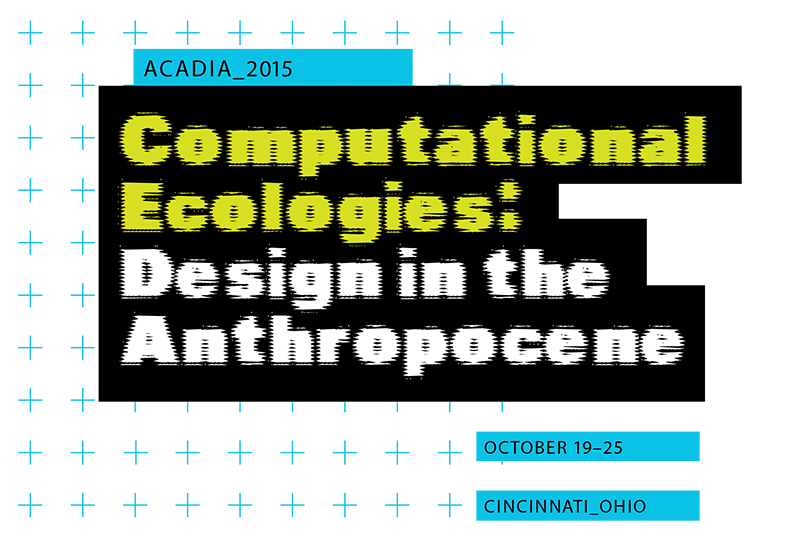ABOUT
Contact
About ACADIA
ACADIA was formed for the purpose of facilitating communication and critical thinking regarding the use of computers in architecture, planning, and building science. The organization is committed to the research and development of computational methods that enhance design creativity and that aim to contributing to the construction of humane physical environments. A particular focus is placed on education and the software, hardware and pedagogy involved in academia. Please visit the main ACADIA website for more information.
Media Downloads
Emailable Logo:
ACADIA 2015 Topics
Advanced computational design methods, building information modeling, and digital fabrication workshops will precede the conference event. Full research papers, short work-in-progress papers, and juried design and research posters will be presented. Work-in-progress presentations will be enriched by mentoring and structured feedback. Student submissions are especially encouraged, supported by an awards program and travel and accommodation subsidies. The event will be enriched by curated projects including publications on emerging teaching models for complex systems and adaptive architecture, exhibition of architectural prototypes, and installations by visiting student teams. Research papers and exhibition submissions are invited across the range of topic areas that include the following but not limited to:
SPECIFIC THEMES AND TOPICS
• Material science (biomaterials, computational materials, etc.)
• Computational / mimetic design (bio-formalism, geo-formalism, etc.)
• Human / nonhuman architectural programming (computational and actual)
• Environmental parametrics / performance modeling
• Emerging models of digital representation / fabrication
• GIS mapping / data analysis in relation to landscape and urban design
• Geomatics (composite materials and smart assemblies)
• Responsive systems and environments (sensing, real-time computation, actuation, and feedback)
• Climate modeling
Organizers
Conference Chairs

Lonn Combs
ACADIA 2015 Technical Chair
Assistant Professor,
Rensselaer Polytechnic Institute, School of Architecture (link)
Co-founder of EASTON + COMBS (link)
Lonn Combs is an educator and a practicing architect with degrees from Columbia University (MScAAD 2001) and the University of Kentucky (B.Arch 1992). Lonn Combs was awarded the Rome Prize in Architecture in 2012.
Lonn Combs co-founded EASTON+COMBS with partner Rona Easton in 2004. EASTON+COMBS is focused on innovative building strategies through the convergence of material practice, digital methodology and applied architectural research. Among other awards, EASTON+COMBS received the Architecture League of New York award for emerging practices in New York City (2010).
Chris Perry
ACADIA 2015 Technical Chair
Assistant Professor, Head of Graduate Studies
Rensselaer Polytechnic Institute, School of Architecture (link)
Co-founder of pneumastudio (link)
Director, Geofutures (link)
Chris Perry holds a Master of Architecture from Columbia University where he received an Award for Excellence in Design. After two years working as a project designer for Stan Allen (SAA) and ten years as principal of his first design practice servo, he co-founded his current practice pneumastudio in 2011.
Formed in 2011, pneumastudio has exhibited its work at the Design Museum in Barcelona and New York University’s Gallatin School of Individualized Study. Perry is a recipient of the Architectural League of New York’s Prize for Young Architects and Designers and The MacDowell Colony Fellowship.
William Williams
ACADIA 2015 Site Chair
Director, School of Architecture and Interior Design, Registered Architect,
University of Cincinnati, School of Architecture and Interior Design (link)
William Williams received his Master of Architecture from Harvard GSD in 1991 and his undergraduate degree from the University of Houston in 1989. Prior to joining the University of Cincinnati he taught at the University of Virginia, Rice University, University of Houston, UC Berkeley, and UCLA.
His teaching and research focus on affordable housing and culture-specific topics in art and architecture. In 2004 he co-authored ROW: Trajectories through the Shotgun House . His work has been funded by the National Endowment for the Arts in 1995, 2000, and 2006, and by the Graham Foundation in 2005.
Mara Marcu
ACADIA 2015 Exhibitions, Website, Social Media
Assistant Professor, LEED AP
University of Cincinnati, School of Architecture and Interior Design (link)
Founder of MM13 (link)
Mara Marcu received her Master of Architecture from Harvard GSD in 2009 and her undergraduate degree from the University of Houston in 2005. She is also a graduate of the International Master Class with Glenn Murcutt - Australia and Ghost Lab 7 with Brian MacKay-Lyons - Canada.
Her teaching and research focus on providing for a digital and material workflow that connects design, fabrication, and culture-specific topics. Mara was awarded the Best in Show Design Award upon graduation by the University of Houston and is the recipient of the University of Virginia Fellowship in 2011.
Brian Ringley
ACADIA 2015 Workshops and Social Media
Design Technology Platform Specialist, Woods Bagot (link)
Visiting Assistant Professor, Pratt Institute (link)
Brian Ringley is on the Global Design Technology Team at Woods Bagot where he leads efforts around Rhino, Grasshopper, fabrication, and analysis workflows, curates and develops custom digital toolsets, and provides intensive project assistance for globally significant projects with high degrees of complexity.
He taught at City Tech (CUNY) and currently teaches at Pratt Institute’s GAUD. Prior to Woods Bagot, he worked for KPF in New York and London, Dellekamp Arquitectos in Mexico City, and R&Sie(n) in Paris. He is a regular contributor to Designalyze.com, a design computation education site, and AEC-APPS.com, an award-winning AEC software database community.
Stephen Slaughter
ACADIA 2015 Site Related Events and Publications
Assistant Professor,
University of Cincinnati, School of Architecture and Interior Design (link)
After graduating with a Masters of Architecture from The Ohio State University, Slaughter has initiated his career in Thom Mayne’s studio, Morphosis. As a professional, with nearly 20 years in practice, his experience spans a wide range of projects.
In 2004 he co-founded PHAT, which has exhibited at the Studio Museum in Harlem, the National Gallery of Victoria, and ArchiLab in Orléans. His teaching synthesizes technical expertise with a research agenda pursuant of innovative and unconventional design solutions to real world problems facing the underserved.
Ming Tang
ACADIA 2015 Website, Site Related Events and Publications
Assistant Professor, LEED AP, AIA
University of Cincinnati, School of Architecture and Interior Design (link)
Co-founder of Tang & Yang Architects (link)
Ming Tang is an Assistant Professor at the University of Cincinnati, a registered architect, and founding partner of Tang & Yang Architects. The firm has won numerous design awards, including first place in d3 Natural System Competition, IAAC self-sufficient housing contest, and Chichen Itza lodge museum design competition.
His research includes parametric design, digital fabrication, building information modeling, virtual reality, human-computer interaction (HCI), and performance-driven design. His book, Parametric Building Design with Autodesk Maya was published by Routledge in 2014.
